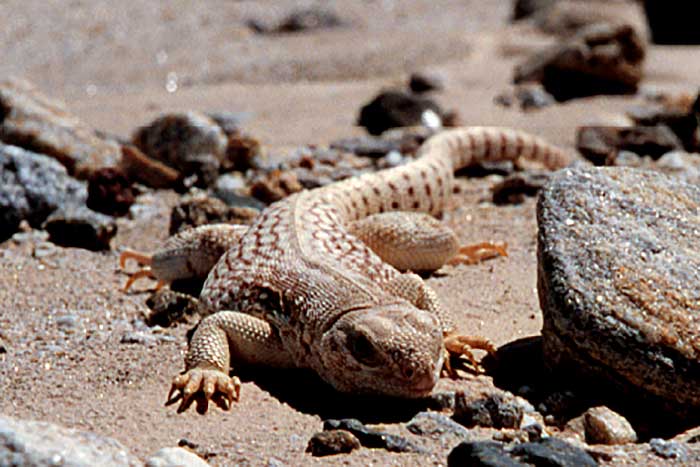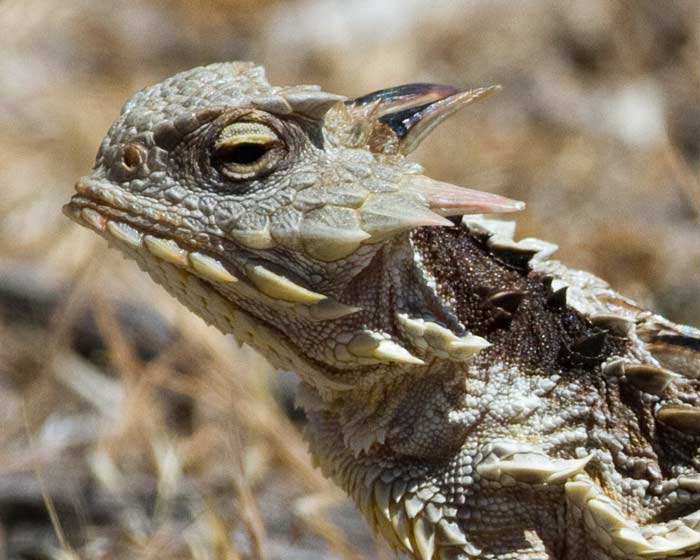Reptiles
Anza-Borrego Desert State Park

Today's reptiles have changed very little in appearance from the days of the Cretaceous period when they co-existed and competed with the giant, warm-blooded dinosaurs over 100 million years ago. Whatever caused the extinction of the dinosaurs was insufficient to wipe out these smaller members of a once dominant class of animals.

Western Zebra-tailed Lizard
Reptiles are probably the one animal group visitors most associate with desert habitats. Anza-Borrego Desert State Park protects the richest concentration of lizards and snakes in California. Over 50 different species can be found in Borrego's 600,000 acres. This very high diversity is probably due to the extreme variety of habitats found in our park. Elevation ranges from 300 feet above sea level to over 6,000 feet at Combs peak. With a wide variety of geologic terrain and vegetation cover, Anza-Borrego is an enormously complex ecosystem.
Reptile Biology
The harsh and challenging desert environment forces all desert animals to solve the dual physiological problem of regulating body temperature and maintaining a water balance. All reptiles are ectotherms a word denoting organisms that utilize heat sources outside their bodies to maintain a preferred temperature range. reptiles are so abundant in deserts because the high average temperatures and intense sunshine found in North American deserts are ideal for "cold-blooded" animals. It is much easier for an ectotherm to thermoregulate within the preferred temperature range for longer periods of the day and year in warm deserts than in cooler climates. For example, a snake living at 9,000 feet in the Sierra may only be active for thirty days out of the year. A Red Diamond Rattlesnake can be active form more than 8 months in the desert. When a cool and sluggish lizard or snake crawls out of its refuge in the morning it immediately orients its body to maximize absorption of radiation from the sun. Once it reaches its optimum body temperature, it uses a variety of behavioral techniques to stay within its preferred range.

Horned Lizard
One technique is to move back and forth between shade and sun, continually fine tuning its radiant exposure. Another way is to utilize conduction by pressing its body against a cool substrate such as the inside surface of a rock or crevice or by pushing aside soft sand maximizing contact with its belly. For desert reptiles, active body temperatures fall in the range of 88 to 102 degrees Fahrenheit with an average of 95 degrees. The abundant Desert iguana has adapted its physiology so that it is regularly active between 110 and 115 degrees Fahrenheit, only about 3 degrees lower than its lethal temperature of 118 degrees! Oddly enough, other desert reptiles are quite similar to their relatives native to cooler climates in their heat tolerance. A possible explanation for this is that North American deserts are very young (only 10,000 - 15,000 years since last ice age). There has not been enough time for evolution to change biochemical tolerances to very high temperatures. older deserts such as the Great Victoria desert in Western Australia have a much more diverse lizard community, with as many a three times more species living within a comparable area.
The lethal temperature of snakes is lower than that of lizards. most snakes are nocturnal, avoiding heat extremes, while most lizards are active only in the daytime.
Perhaps the main advantage reptiles possess is the efficient use of food. Typically, a reptile has one-seventh the metabolic rate of a similarly sized mammal. This translates to one seventh the amount of food needed to survive during active periods. This also means reptiles breathe less often, conserving water that would otherwise be lost. Most deserts, including Anza-Borrego, are very undependable in providing a steady supply of food for carnivores. Reptiles easily go into dormancy during warm months or hibernate in winter surviving on stored fat. This ability to survive prolonged drought is a distinct advantage for reptiles.
Due to their limited ability to travel long distances, reptiles must be able to obtain sufficient water solely from their food. Desert reptiles generally cannot exist on food with a water content of less than 60% Of the water lost by reptiles, 30% to 40% is lost through their feces even though these are usually dry. The remaining water is lost equally via respiration and through the skin.
All reptiles possess a thick, scaly skin composed of pliable alpha keratin on the inner surface and stiffer, harder beta keratin on the outer exposed surface. Keratin is the structural protein found in human nails and in bird feathers. Only the reptiles produce the beta form. Reptile skin greatly reduces the loss of water by evaporation compared to mammal or bird skin.
Common Reptiles of Anza-Borrego
The Zebra-tailed lizard is the reptile most frequently seen by park visitors. His beautifully, camouflaged lizard is also north America is fastest reptile. Sprinting at a top speed of 18 miles per hour, it often raises its front legs off the ground and runs with a bipedal stance. it is strictly carnivorous, capturing small insects with a sit and wait hunting strategy. When it spots a crawling beetle or grasshopper, it suddenly dashes out from its resting site and snaps it up before retreating to safety.
Western Whiptails are another commonly seen lizard. in contrast tot he sit and wait strategy for capturing prey, Whiptails are continually active hunters. They search incessantly for grubs, spiders, buried eggs, and all types of insects. Like most lizards they have a breakaway tail that wiggles violently when pulled off. This remarkable adaptation allows the lizard to distract the attacking predator long enough to escape and survive. The predator in turn gains a high protein snack!

The Chuckwalla is Anza-Borrego's largest lizard with a total body length of up to sixteen inches. This rock-dwelling lizard is a strict herbivore that feeds on the flowers, berries, and leaves of a wide variety of desert plants. When confronted by a predator, a Chuckwalla quickly rushes back to its favorite rock crevice and starts swallowing air. Once inflated it becomes wedged against the rock, making extraction extremely difficult. Like most lizards, the Chuckwallas are highly territorial, aggressively chasing away rival males. Old males with the longest tail attract a "harem" of females, reminiscent of many mammal social groups.
The Coachwhip is one of the few dinural snakes found in the desert. These active foragers can be seen even during the hottest days of summer. moving rapidly between shrubs and tress to avoid the hot sunny patches of the ground, they continually search for lizards, eggs and nesting birds.
The Sidewinder, one of four species of rattlesnakes found in the Park is the most highly evolved reptile in North America. All rattlesnakes have developed a highly toxic venom used to subdue prey and they have perfected a delivery system consisting of hollow retractable fangs. They have also evolved a warning device (the rattle) comprised of interlocking hollow buttons of dead skin. Rattlesnakes possess highly specialized sensory organs, called loreal pits, that can help them pinpoint the location of prey in total darkness. These receptors, located on either side of the snout, are able to detect subtle differences in infra-red radiation (heat rays). This allows a rattlesnake to  form a binocular image that permits depth perception enabling the snake to precisely locate and strike its warm-blooded prey in complete darkness. During the warm months of late spring and summer, rattlesnakes are completely nocturnal, preferring moonless nights for stalking their prey of rats, mice and baby rabbits.
form a binocular image that permits depth perception enabling the snake to precisely locate and strike its warm-blooded prey in complete darkness. During the warm months of late spring and summer, rattlesnakes are completely nocturnal, preferring moonless nights for stalking their prey of rats, mice and baby rabbits.
The Sidewinder is named for the unique form of locomotion that it utilizes almost exclusively. Sidewinding is ideal for moving fast over loose, sandy substrates such as sand dunes or mesquite hummocks. Another name for the Sidewinder is the Horned Rattler. The "horns" are actually enlarged scales above the eyes that fold down over the eyes when slight pressure is applied. A Sidewinder moving through a tight rodent burrow, where eyesight is useless, uses the horns as tough shield protecting the eyes from permanent damage.
Threats
People are by far the biggest threat to reptiles worldwide. Mass destruction of natural vegetation for agriculture or grazing is wiping out millions of acres of reptile habitat every year. In the United States additional losses come from senseless killing of snakes either from irrational fear or from ignorance. Many states allow and promote rattlesnake "round-ups" where thousands are killed for the fun of it.
Throughout North American poaching is on the increase. Collecting rare snakes and lizards is becoming an increasingly popular hobby. Recently, a ranger stopped a suspicious van moving slowly on a paved road inside the park. The driver was a well known poacher. His passengers were buyers from Asia and Europe.
Rangers need your help. If you see anyone collecting reptiles in Anza-Borrego Desert state Park, write down their license plate number and notify a ranger. by protecting reptiles you are helping to preserve an ancient, fascinating group of animals that are essential members of an infinitely complex and fragile ecosystem.
By Chris Smith Anza-Borrego Desert State Park
Related DesertUSA Pages
- How to Turn Your Smartphone into a Survival Tool
- 26 Tips for Surviving in the Desert
- Death by GPS
- 7 Smartphone Apps to Improve Your Camping Experience
- Maps Parks and More
- Desert Survival Skills
- How to Keep Ice Cold in the Desert
- Desert Rocks, Minerals & Geology Index
- Preparing an Emergency Survival Kit
Share this page on Facebook:
The Desert Environment
The North American Deserts
Desert Geological Terms

Click here to see current desert temperatures!



